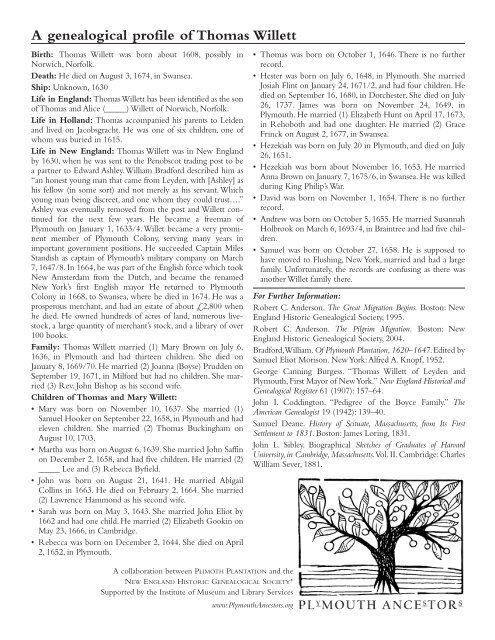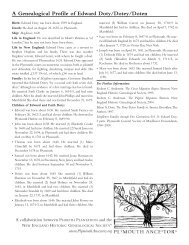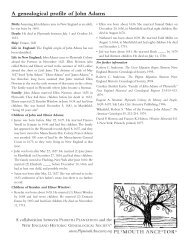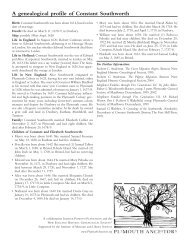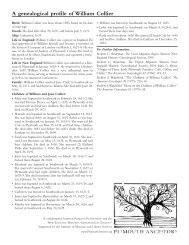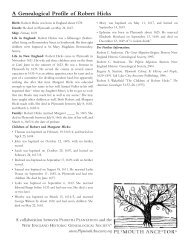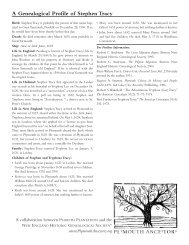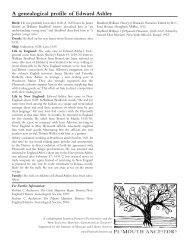plimoth sketches 05 - post 1627.qxp - Plimoth Plantation
plimoth sketches 05 - post 1627.qxp - Plimoth Plantation
plimoth sketches 05 - post 1627.qxp - Plimoth Plantation
You also want an ePaper? Increase the reach of your titles
YUMPU automatically turns print PDFs into web optimized ePapers that Google loves.
A genealogical profile of Thomas Willett<br />
Birth: Thomas Willett was born about 1608, possibly in<br />
Norwich, Norfolk.<br />
Death: He died on August 3, 1674, in Swansea.<br />
Ship: Unknown, 1630<br />
Life in England: Thomas Willett has been identified as the son<br />
of Thomas and Alice (_____) Willett of Norwich, Norfolk.<br />
Life in Holland: Thomas accompanied his parents to Leiden<br />
and lived on Jacobsgracht. He was one of six children, one of<br />
whom was buried in 1615.<br />
Life in New England: Thomas Willett was in New England<br />
by 1630, when he was sent to the Penobscot trading <strong>post</strong> to be<br />
a partner to Edward Ashley.William Bradford described him as<br />
“an honest young man that came from Leyden, with [Ashley] as<br />
his fellow (in some sort) and not merely as his servant. Which<br />
young man being discreet, and one whom they could trust….”<br />
Ashley was eventually removed from the <strong>post</strong> and Willett continued<br />
for the next few years. He became a freeman of<br />
Plymouth on January 1, 1633/4. Willet became a very prominent<br />
member of Plymouth Colony, serving many years in<br />
important government positions. He succeeded Captain Miles<br />
Standish as captain of Plymouth’s military company on March<br />
7, 1647/8. In 1664, he was part of the English force which took<br />
New Amsterdam from the Dutch, and became the renamed<br />
New York’s first English mayor He returned to Plymouth<br />
Colony in 1668, to Swansea, where he died in 1674. He was a<br />
prosperous merchant, and had an estate of about £2,800 when<br />
he died. He owned hundreds of acres of land, numerous livestock,<br />
a large quantity of merchant’s stock, and a library of over<br />
100 books.<br />
Family: Thomas Willett married (1) Mary Brown on July 6,<br />
1636, in Plymouth and had thirteen children. She died on<br />
January 8, 1669/70. He married (2) Joanna (Boyse) Prudden on<br />
September 19, 1671, in Milford but had no children. She married<br />
(3) Rev. John Bishop as his second wife.<br />
Children of Thomas and Mary Willett:<br />
Mary was born on November 10, 1637. She married (1)<br />
Samuel Hooker on September 22, 1658, in Plymouth and had<br />
eleven children. She married (2) Thomas Buckingham on<br />
August 10, 1703.<br />
Martha was born on August 6, 1639. She married John Saffin<br />
on December 2, 1658, and had five children. He married (2)<br />
_____ Lee and (3) Rebecca Byfield.<br />
John was born on August 21, 1641. He married Abigail<br />
Collins in 1663. He died on February 2, 1664. She married<br />
(2) Lawrence Hammond as his second wife.<br />
Sarah was born on May 3, 1643. She married John Eliot by<br />
1662 and had one child. He married (2) Elizabeth Gookin on<br />
May 23, 1666, in Cambridge.<br />
Rebecca was born on December 2, 1644. She died on April<br />
2, 1652, in Plymouth.<br />
A collaboration between PLIMOTH PLANTATION and the<br />
NEW ENGLAND HISTORIC GENEALOGICAL SOCIETY ®<br />
Supported by the Institute of Museum and Library Services<br />
www.PlymouthAncestors.org<br />
Thomas was born on October 1, 1646. There is no further<br />
record.<br />
Hester was born on July 6, 1648, in Plymouth. She married<br />
Josiah Flint on January 24, 1671/2, and had four children. He<br />
died on September 16, 1680, in Dorchester. She died on July<br />
26, 1737. James was born on November 24, 1649, in<br />
Plymouth. He married (1) Elizabeth Hunt on April 17, 1673,<br />
in Rehoboth and had one daughter. He married (2) Grace<br />
Frinck on August 2, 1677, in Swansea.<br />
Hezekiah was born on July 20 in Plymouth, and died on July<br />
26, 1651.<br />
Hezekiah was born about November 16, 1653. He married<br />
Anna Brown on January 7, 1675/6, in Swansea. He was killed<br />
during King Philip’s War.<br />
David was born on November 1, 1654. There is no further<br />
record.<br />
Andrew was born on October 5, 1655. He married Susannah<br />
Holbrook on March 6, 1693/4, in Braintree and had five children.<br />
Samuel was born on October 27, 1658. He is supposed to<br />
have moved to Flushing, New York, married and had a large<br />
family. Unfortunately, the records are confusing as there was<br />
another Willet family there.<br />
For Further Information:<br />
Robert C. Anderson. The Great Migration Begins. Boston: New<br />
England Historic Genealogical Society, 1995.<br />
Robert C. Anderson. The Pilgrim Migration. Boston: New<br />
England Historic Genealogical Society, 2004.<br />
Bradford,William. Of Plymouth <strong>Plantation</strong>, 1620–1647. Edited by<br />
Samuel Eliot Morison. New York:Alfred A. Knopf, 1952.<br />
George Canning Burgess. “Thomas Willett of Leyden and<br />
Plymouth, First Mayor of New York.” New England Historical and<br />
Genealogical Register 61 (1907): 157–64.<br />
John I. Coddington. “Pedigree of the Boyce Family.” The<br />
American Genealogist 19 (1942): 139–40.<br />
Samuel Deane. History of Scituate, Massachusetts, from Its First<br />
Settlement to 1831. Boston: James Loring, 1831.<br />
John L. Sibley. Biographical Sketches of Graduates of Harvard<br />
University, in Cambridge, Massachusetts.Vol. II. Cambridge: Charles<br />
William Sever, 1881.
Researching your family’s history can be a fun, rewarding, and occasionally<br />
frustrating project. Start with what you know by collecting information<br />
on your immediate family. Then, trace back through parents,<br />
grandparents, and beyond.This is a great opportunity to speak to relatives,<br />
gather family stories, arrange and identify old family photographs, and<br />
document family possessions that have been passed down from earlier<br />
generations.<br />
Once you have learned all you can from family members, you will<br />
begin to discover other sources. A wide variety of records can help you learn more about the lives of your ancestors.These<br />
include birth, marriage, and death records; immigration and naturalization records; land records; census records; probate records<br />
and wills; church and cemetery records; newspapers; passenger lists; military records; and much more.<br />
When you use information from any source — an original record, a printed book, or a website — always be careful to document<br />
it. If you use a book, you should cite the author or compiler, the full title, publication information and pages used.Also<br />
be sure to record the author’s sources for the information. If the author’s sources aren’t provided, you will have to try to find<br />
the original source. Many genealogical works contain faulty information, and the Internet also contains many inaccuracies. In<br />
order for your work to be accepted — by lineage societies and other genealogists — it must be properly documented.<br />
IMPORTANT GENEALOGICAL RESOURCES<br />
New England Historic Genealogical Society<br />
Founded in 1845, NEHGS is the country’s oldest and largest<br />
genealogical society.The library contains over 200,000 books,<br />
plus significant manuscript and microfilm collections, and a circulating<br />
library by mail. NEHGS members receive two periodicals,<br />
the Register and New England Ancestors, and can access<br />
valuable genealogical data online.<br />
NEHGS, 101 Newbury St., Boston, MA 02116;<br />
888-296-3447; www.NewEnglandAncestors.org.<br />
<strong>Plimoth</strong> <strong>Plantation</strong>: Bringing Your History To Life<br />
As a non-profit, educational organization our mission is: to offer<br />
the public powerful experiences of history, built upon thorough<br />
research of the Wampanoag and Pilgrim communities.We offer<br />
multiple learning opportunities to provide a deeper understanding<br />
of the relationship of historical events to modern America.<br />
Members have access to our Research Library.<br />
<strong>Plimoth</strong> <strong>Plantation</strong>, 137 Warren Avenue, Plymouth, MA 02632;<br />
508-746-1622; www.<strong>plimoth</strong>.org<br />
RECOMMENDED WEBSITES<br />
www.PlymouthAncestors.org<br />
www.CyndisList.com<br />
www.FamilySearch.org<br />
www.USGenWeb.org<br />
GENEALOGICAL LIBRARIES IN PLYMOUTH<br />
General Society of Mayflower Descendants Library<br />
A collection focused principally on the genealogies of the<br />
descendants of the Mayflower passengers.<br />
4 Winslow St., Plymouth; 508-746-3188; www.mayflower.org<br />
Plymouth Collection, Plymouth Public Library<br />
Over 1200 items relating to the descendants of the Pilgrims, as<br />
well as the many other immigrants who settled in the area.<br />
132 South St., Plymouth; 508-830-4250;<br />
www.plymouthpubliclibrary.org<br />
RECOMMENDED BOOKS<br />
The Complete Idiot’s Guide to Genealogy by Christine Rose and<br />
Kay Germain Ingalls,Alpha Books, 1997.<br />
Genealogist’s Handbook for New England Research by Marcia<br />
Melnyk, NEHGS, 1999.<br />
Shaking Your Family Tree:A Basic Guide to Tracing Your Family<br />
History by Ralph J. Crandall, NEHGS, 2001.<br />
Unpuzzling Your Past by Emily Croom, Betterway Books, 2003.<br />
A collaboration between PLIMOTH PLANTATION and the<br />
NEW ENGLAND HISTORIC GENEALOGICAL SOCIETY ®<br />
www.PlymouthAncestors.org


